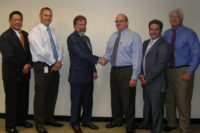Heating, Airconditioning and Refrigeration Distributors International (HARDI) reported North American HVACR average distributor sales for December 2011were down 12.2% from record growth in the tax-credit-expiration-infused December 2010, the second consecutive month of decline after 12 straight months of growth. HARDI distributors’ annual growth rate fell below 5% for the first time all year.
HARDI’s Monthly Targeted and Regional Economic News for Distribution Strategies (TRENDS) Report showed declines in all seven U.S. regions, but each U.S. region ended 2011 in the positive. The opposite was true for Canada which was the only HARDI region to see growth in December, but not enough to pull 2011 to the positive. U.S.-only distributor sales were -12.5% for the month. However, all eight HARDI regions reported higher inventory levels than the same time last year.
“December was a difficult month for distributors, said HARDI economist,Andrew Duguay. “Average sales for the month were 12.2% lower than December of 2010. Eighty percent of distributors reported that their sales in December were lower than last year. The clear cause of the poor year-over-year comparisons is the $1,500 energy efficiency tax credit expiration at the end of last December, causing a boost in sales as people rushed to buy units and claim the credit. December weather was also seasonably mild throughout the majority of the U.S., which may have caused a minor, short-term shifting of consumer habits in heating equipment purchases.”
Days Sales Outstanding (a measure of how quickly customers pay their bills) snapped a four-month decline with very modest improvement this month. Distributor productivity reflected by sales per employee backtracked for the sixth consecutive month down 5% from last month and nearly 30% from its July peak.
“Last February we forecasted 5% growth for HARDI distributors in 2011 having already seen nearly across-the-board price increases,” said HARDI Executive Vice President and C.O.O.Talbot Gee. “But unfortunately the market failed to outpace those price increases and ended on a disappointing note. We knew the fourth quarter comparisons were going to be tough, and our average December declines still significantly outperformed the 30+% declines we saw in equipment volumes.”
“Interestingly we did see a sharp decline in R-22 ‘dry-shipped’ unitary volumes steadily throughout the fourth quarter, following a more traditional repair part historical trend, so we’ll have to factor that into our forecasting for 2012.”
Source: HARDI






